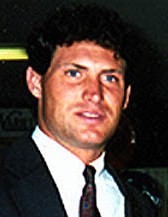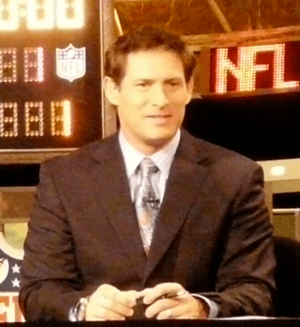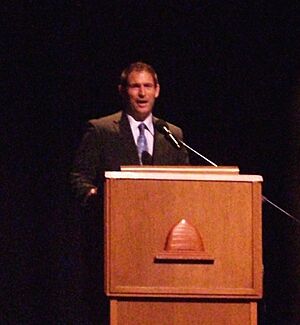Steve Young facts for kids
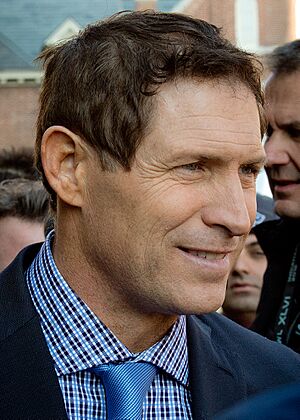
Young in 2012
|
|||||||||||||||||
| No. 8 | |||||||||||||||||
|---|---|---|---|---|---|---|---|---|---|---|---|---|---|---|---|---|---|
| Position: | Quarterback | ||||||||||||||||
| Personal information | |||||||||||||||||
| Born: | October 11, 1961 Salt Lake City, Utah, U.S. |
||||||||||||||||
| Height: | 6 ft 2 in (1.88 m) | ||||||||||||||||
| Weight: | 215 lb (98 kg) | ||||||||||||||||
| Career information | |||||||||||||||||
| High school: | Greenwich (Greenwich, Connecticut) | ||||||||||||||||
| College: | BYU (1980–1983) | ||||||||||||||||
| Supplemental draft: | 1984 / Round: 1 | ||||||||||||||||
| Career history | |||||||||||||||||
|
|||||||||||||||||
| Career highlights and awards | |||||||||||||||||
|
|||||||||||||||||
| Career NFL statistics | |||||||||||||||||
|
|||||||||||||||||
| Player stats at PFR | |||||||||||||||||
|
Pro Football Hall of Fame
|
|||||||||||||||||
|
College Football Hall of Fame
|
|||||||||||||||||
Jon Steven Young, born on October 11, 1961, is a famous American football player. He was a quarterback in the National Football League (NFL) for 15 seasons. He is best known for his time with the San Francisco 49ers. Before joining the NFL, Young played for the Los Angeles Express in the United States Football League (USFL).
Young also played college football for the BYU Cougars. He set many school and NCAA records. In 1983, he was almost chosen for the Heisman Trophy. After playing in the USFL, Young joined the Tampa Bay Buccaneers in 1985. He was later traded to the 49ers in 1987.
For several years, Young was the backup quarterback to Joe Montana. Montana had already led the 49ers to four Super Bowl wins. Young became the main starting quarterback in 1991. He was named the NFL's Most Valuable Player (MVP) in 1992 and 1994. Young was also the MVP of Super Bowl XXIX. In that game, he led the 49ers to victory with a record six touchdown passes.
Young was a very accurate passer. He led the league in passer rating six times, which is a record. He also led the league in completion percentage and yards per attempt five times. When he retired, Young had the highest passer rating among NFL quarterbacks with many passing attempts. He is a member of both the College Football Hall of Fame and the Pro Football Hall of Fame.
Contents
Early Life and High School Football
Steve Young was born in Salt Lake City, Utah. He went to Eastern Middle School and then Greenwich High School in Greenwich, Connecticut. There, he played quarterback for the Cardinals football team.
In his junior year, Young earned honors in the All-FCIAC West Division. This was his first year as a starter. In his senior year, Young scored 13 rushing touchdowns. He was again named to the All-FCIAC West Division First Team. He also made the CIAC All-State team.
Greenwich High School used an offense that focused on running the ball. Young completed 41 percent of his passes for 1,220 yards. But he ran the ball 267 times for 1,928 yards. Young was also a co-captain for the football, basketball, and baseball teams in his senior year.
College Football Career
Many colleges wanted Young to play for them, including the University of North Carolina. However, Young chose to go to BYU. At first, he found it hard to throw the ball well. The BYU coaches even thought about moving him to defensive back. But Young worked very hard to improve his passing.
He eventually became the starting quarterback after Jim McMahon. Young threw for 3,902 yards and 33 touchdowns in the regular season. His 71.3% completion rate set an NCAA record for a single season. He also ran for 544 yards. With Young, BYU's offense set an NCAA record by gaining 584.2 total yards per game.
Young was named a unanimous All-American and won the Davey O'Brien National Quarterback Award. This award goes to the best college quarterback each year. He finished second in the voting for the Heisman Trophy. Young ended his college career by scoring the winning touchdown in BYU's 21–17 win over Missouri in the 1983 Holiday Bowl.
He finished his college career with 7,733 passing yards and 56 touchdowns. He also had 1,048 rushing yards and 18 rushing touchdowns. Young was inducted into the College Football Hall of Fame in 2001.
Professional Football Journey
When Young finished college, the USFL was a new league that was competing with the NFL. He had the choice to be a top player in either league.
Los Angeles Express (USFL)
The USFL's Los Angeles Express chose Young in the 1984 draft. He signed a large 10-year contract with the Express in March 1984. Young missed the first six games of his rookie season to finish college. He then started the last 12 games. He became the first pro football player to pass for 300 yards and rush for 100 yards in one game.
The Express struggled to attract fans in Los Angeles. The team faced financial problems. By the end of the 1984 season, the team's owner had to give up control. The league took over the team and cut its budget. This meant they couldn't replace injured players. Young and other players realized the Express might not last.
Before the Express's last home game, the team bus driver refused to leave without being paid in cash. Young and the team trainer helped pay the driver. In the final game of the season, Young even had to play as a running back because there were no healthy running backs left.
Tampa Bay Buccaneers
Young became unhappy with the problems of the Express. He asked the USFL to find a new owner or let him leave for the NFL. The league decided to stop the Express's operations for the 1986 season. Young then bought out his contract and signed with the Tampa Bay Buccaneers. The Buccaneers had chosen him in a special draft a year earlier.
The Buccaneers were going through a tough time, losing many games. They had a 2–14 record in both of Young's seasons with them. Young threw for only 11 touchdowns and 21 interceptions during his time there.
San Francisco 49ers
The Buccaneers chose another quarterback, Vinny Testaverde, in the 1987 NFL draft. They traded Young to the San Francisco 49ers on April 24, 1987. He was meant to be a backup to Joe Montana. 49ers coach Bill Walsh saw Young's talent. He believed Young's poor stats in Tampa Bay were due to the lack of good players around him.
Backing Up Joe Montana: 1987–1990
Young played behind Montana for four years. But he showed great skill as a backup. In a 1987 game against the Chicago Bears, Young replaced an injured Montana. He threw four touchdown passes in a 41–0 victory. In a playoff game against the Minnesota Vikings, he replaced Montana in the second half. Young completed 12 of 17 passes for 158 yards and a touchdown. He also ran for 72 yards and a touchdown.
On October 30, 1988, Young ran for a 49-yard, game-winning touchdown against the Minnesota Vikings. This was the longest run by a 49ers quarterback for many years. Young also threw a 73-yard touchdown pass to John Taylor in that game. The 49ers won 24–21. This win was very important. Without it, the 49ers would have missed the playoffs. Instead, they won their division and went on to win Super Bowl XXIII.
In 1989, Young showed he could be a future starter. Montana won the NFL MVP award and led the team to a Super Bowl XXIV victory. But Young also had a good season. He completed 69% of his passes for 1,001 yards, with eight touchdowns and only three interceptions. On October 22, 1989, he had a perfect passer rating of 158.3. He completed 11 of 12 passes for 188 yards and three touchdowns in a 37–20 win.
Young rushed for a career-high 102 yards against the New Orleans Saints on December 23, 1990. He was only the second 49ers quarterback to rush for over 100 yards in a game. In his four seasons as a backup, Young threw 23 touchdown passes and only six interceptions.
Becoming the Starter: 1991 Season
After Montana injured his elbow, Young got his chance to lead the 49ers in the 1991 season. He had a tough start. The 49ers had a 4–4 record halfway through the season. Young then suffered a knee injury and was replaced by backup quarterback Steve Bono. Bono played well, leading the 49ers to five wins. Coach George Seifert kept Bono as the starter even after Young recovered.
Young played again late in the season when Bono got injured. Young finished the season strong. He threw for 338 yards and three touchdowns. He also rushed for 63 yards and another touchdown in a 52–14 win over the Chicago Bears.
Young finished the season with an NFL-best 101.8 passer rating. He threw for 2,517 yards, 17 touchdowns, and only eight interceptions. The 49ers finished with a 10–6 record, but missed the playoffs. Many thought Young might be traded when Montana returned. However, the trade did not happen.
First MVP Season: 1992
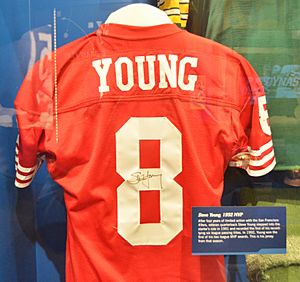
At the start of the 1992 season, Young's starting job was still uncertain. Montana was recovering from elbow surgery. Young started the season but suffered a concussion in the first game. He was replaced by Bono, who led the 49ers to a 31–14 victory. The next week, the 49ers lost 34–31 to the Buffalo Bills. Young threw for a career-high 449 yards and three touchdowns in that game.
Young then led the 49ers on a five-game winning streak. This included a 56–17 victory over the Atlanta Falcons. In that game, he passed for 399 yards and three touchdowns. Young led San Francisco to a 14–2 record for the season. He threw for 227 yards and two touchdowns and rushed for 73 yards in a playoff win. However, the 49ers lost the NFC Championship game to the Dallas Cowboys.
Young finished the season with 3,465 passing yards and 537 rushing yards. He also had an NFL-best 25 touchdown passes and a 107.0 passer rating. He won the NFL Most Valuable Player Award and was selected for his first Pro Bowl. Young was the first quarterback to have a triple-digit rating in two seasons in a row.
1993 Season
Before the 1993 season, the 49ers owner wanted Montana to be the starting quarterback again. But there was disagreement among the players. In the spring of 1993, Montana was traded to the Kansas City Chiefs. Young was now the clear starting quarterback for the 49ers.
Young had a difficult start to the 1993 season. He threw eight interceptions in the first four games. This was more than he threw in all of 1992. But after his thumb healed, Young played incredibly well. Over seven games, he threw 16 touchdown passes with only two interceptions.
By the end of the year, Young set team records for most passing yards (4,023) and consecutive passes without an interception (189). He led the NFL in touchdown passes (29) and passer rating (101.5). The team finished with a 10–6 record. They won their first playoff game 44–3 against the New York Giants. But they lost again to the Dallas Cowboys in the NFC Championship game, 38–21.
Second MVP and Super Bowl Win: 1994
After signing new players, the 49ers aimed to win their first Super Bowl since 1989. They started strong, beating the Los Angeles Raiders 44–14. Young threw four touchdown passes in that game. After a loss to Joe Montana and the Kansas City Chiefs, the 49ers won two more games.
Then they lost to the Philadelphia Eagles 40–8. Young was benched during this game. He was very upset with coach George Seifert. This game became a turning point for the season. From then on, Young led the team to 10 wins in a row. The 49ers finished with a 13–3 record, the best in the NFL. They had the number-one offense.
After easily beating the Chicago Bears 44–15 in the playoffs, the 49ers faced the Dallas Cowboys again. They led 31–14 at halftime and won 38–28. Young threw two touchdowns and ran for another. This sent him to his first Super Bowl as a starting quarterback.
In Super Bowl XXIX, Young had an amazing performance. He threw six touchdown passes, breaking Joe Montana's Super Bowl record of five. Young was named the Super Bowl MVP as the 49ers defeated the San Diego Chargers 49–26. He also threw for 325 yards and rushed for 49 yards. He was the first player to lead a Super Bowl in both rushing and passing yards.
This victory completed an incredible year for Young. He had one of the best seasons ever for a quarterback. He threw for 3,969 yards and a team-record 35 touchdown passes. He completed 70.3 percent of his passes, the highest in the 1990s. Young also broke Joe Montana's record with a 112.8 passer rating. He ran for 289 yards and seven touchdowns. For his amazing season, Young won his second AP NFL MVP award.
Later Years and Injuries
In the three years after Super Bowl XXIX, the 49ers lost in the playoffs to Brett Favre and the Green Bay Packers each year. Young also suffered several injuries from 1995 to 1997.
In the 1998 season, Young was 37 years old. Some wondered if his skills were declining. But Young proved them wrong. He had career-high numbers in passing yards (4,170) and passing touchdowns (36). The 49ers finally beat the Packers in the playoffs that year. Young threw the winning touchdown to Terrell Owens with three seconds left. This play was called "The Catch II".
A week later, Garrison Hearst broke his ankle early in the game. Without a strong running game, Young threw three interceptions. The 49ers lost to the Atlanta Falcons 20–18. From 1995 to 1998, Young led the NFL in passer rating twice and in touchdown passes once.
Final Game and Retirement
On September 27, 1999, Young played against the Arizona Cardinals. He left the game in the second quarter after a hard hit from cornerback Aeneas Williams. Young was knocked unconscious. He walked off the field but did not return to the game. Jeff Garcia took his place.
This was reportedly Young's second concussion that season and at least his seventh overall. He had thought about retiring after earlier concussions. After the season, the 49ers decided Young could not play safely again. They told him he would be released if he did not retire. Young was offered a starting job with the Denver Broncos. However, he chose to retire because of his repeated concussions.
Young and many other retired players are concerned about repeated hits to the head. They worry about the long-term effects of concussions.
Career Statistics and Achievements
USFL Career Stats
| Year | Team | Games | Passing | Rushing | |||||||||||
|---|---|---|---|---|---|---|---|---|---|---|---|---|---|---|---|
| GP | GS | Cmp | Att | Pct | Yds | Avg | TD | Int | Rtg | Att | Yds | Avg | TD | ||
| 1984 | L.A. Express | 12 | 12 | 179 | 310 | 57.7 | 2,361 | 7.6 | 10 | 9 | 80.6 | 79 | 515 | 6.5 | 7 |
| 1985 | L.A. Express | 10 | 10 | 137 | 250 | 54.8 | 1,741 | 7.0 | 6 | 13 | 63.1 | 56 | 368 | 6.6 | 2 |
| Career | 22 | 22 | 316 | 560 | 56.4 | 4,102 | 7.3 | 16 | 22 | 72.8 | 135 | 883 | 6.5 | 9 | |
NFL Career Stats
| Legend | |
|---|---|
| AP NFL MVP | |
| AP NFL MVP & OPOTY | |
| Won the Super Bowl | |
| Led the league | |
| Bold | Career high |
| Year | Team | Games | Passing | Rushing | Sacks | Fumbles | ||||||||||||||
|---|---|---|---|---|---|---|---|---|---|---|---|---|---|---|---|---|---|---|---|---|
| GP | GS | Record | Cmp | Att | Pct | Yds | Avg | TD | Int | Rtg | Att | Yds | Avg | TD | Sck | SckY | Fum | Lost | ||
| 1985 | TB | 5 | 5 | 1–4 | 72 | 138 | 52.2 | 935 | 6.8 | 3 | 8 | 56.9 | 40 | 233 | 5.8 | 1 | 21 | 158 | 4 | 3 |
| 1986 | TB | 14 | 14 | 2–12 | 195 | 363 | 53.7 | 2,282 | 6.3 | 8 | 13 | 65.5 | 74 | 425 | 5.7 | 5 | 47 | 326 | 11 | 9 |
| 1987 | SF | 8 | 3 | 2–1 | 37 | 69 | 53.6 | 570 | 8.3 | 10 | 0 | 120.8 | 26 | 190 | 7.3 | 1 | 3 | 25 | 0 | 0 |
| 1988 | SF | 11 | 3 | 2–1 | 54 | 101 | 53.5 | 680 | 6.7 | 3 | 3 | 72.2 | 27 | 184 | 6.8 | 1 | 13 | 75 | 5 | 3 |
| 1989 | SF | 10 | 3 | 3–0 | 64 | 92 | 69.6 | 1,001 | 10.9 | 8 | 3 | 120.8 | 38 | 126 | 3.3 | 2 | 12 | 84 | 2 | 1 |
| 1990 | SF | 6 | 1 | 0–1 | 38 | 62 | 61.3 | 427 | 6.9 | 2 | 0 | 92.6 | 15 | 159 | 10.6 | 0 | 8 | 41 | 1 | 1 |
| 1991 | SF | 11 | 10 | 5–5 | 180 | 279 | 64.5 | 2,517 | 9.0 | 17 | 8 | 101.8 | 66 | 415 | 6.3 | 4 | 13 | 79 | 3 | 2 |
| 1992 | SF | 16 | 16 | 14–2 | 268 | 402 | 66.7 | 3,465 | 8.6 | 25 | 7 | 107.0 | 76 | 537 | 7.1 | 4 | 29 | 152 | 9 | 6 |
| 1993 | SF | 16 | 16 | 10–6 | 314 | 462 | 68.0 | 4,023 | 8.7 | 29 | 16 | 101.5 | 69 | 407 | 5.9 | 2 | 31 | 160 | 8 | 6 |
| 1994 | SF | 16 | 16 | 13–3 | 324 | 461 | 70.3 | 3,969 | 8.6 | 35 | 10 | 112.8 | 58 | 293 | 5.1 | 7 | 31 | 163 | 4 | 3 |
| 1995 | SF | 11 | 11 | 8–3 | 299 | 447 | 66.9 | 3,200 | 7.2 | 20 | 11 | 92.3 | 50 | 250 | 5.0 | 3 | 25 | 115 | 3 | 3 |
| 1996 | SF | 12 | 12 | 9–3 | 214 | 316 | 67.7 | 2,410 | 7.6 | 14 | 6 | 97.2 | 52 | 310 | 6.0 | 4 | 34 | 160 | 3 | 2 |
| 1997 | SF | 15 | 15 | 12–3 | 241 | 356 | 67.7 | 3,029 | 8.5 | 19 | 6 | 104.7 | 50 | 199 | 4.0 | 3 | 35 | 220 | 4 | 2 |
| 1998 | SF | 15 | 15 | 11–4 | 322 | 517 | 62.3 | 4,170 | 8.1 | 36 | 12 | 101.1 | 70 | 454 | 6.5 | 6 | 48 | 234 | 9 | 8 |
| 1999 | SF | 3 | 3 | 2–1 | 45 | 84 | 53.6 | 446 | 5.3 | 3 | 4 | 60.9 | 11 | 57 | 5.2 | 0 | 8 | 63 | 2 | 2 |
| Career | 169 | 143 | 94–49 | 2,667 | 4,149 | 64.3 | 33,124 | 8.0 | 232 | 107 | 96.8 | 722 | 4,239 | 5.9 | 43 | 358 | 2,055 | 68 | 49 | |
Records and Legacy
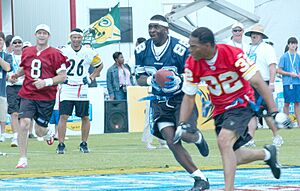
Steve Young became the 49ers' main quarterback in his seventh NFL season. He played a full season only three times in his 15-year career. Despite this, he had a big impact on the NFL. He was a two-time league MVP. He completed 2,667 of 4,149 passes for 33,124 yards. He threw 232 touchdowns and had 107 interceptions. He also scored 43 rushing touchdowns.
Young's career passer rating of 96.8 is one of the highest in NFL history. It is the fourth highest among retired players. His 4,239 rushing yards are the sixth most ever gained by a quarterback. When he retired, Young had the highest career passer rating. He was also second in rushing yards for a quarterback.
He was the NFL's top-rated passer in six different seasons. He led the league in touchdown passes four times. In 20 playoff games, Young threw 20 touchdown passes and scored eight rushing touchdowns. During his time with the 49ers, Young passed for 29,907 yards and 221 touchdowns. His passer rating of 101.4 is the highest in 49ers history.
- NFL Records
- Tenth highest passer rating, career (including active players) – 96.8
- Fourth highest passer rating, career (retired players only) – 96.8
- Eighth highest career completion percentage (retired players) – 64.3%
- Most times led the league in passer rating, career – 6 (tied with Sammy Baugh)
- Most consecutive times led the league in passer rating – 4 (1991–94)
- One of seven QBs to lead the league in touchdown passes 4 times
- Most TD passes, playoff game – 6 (tied with Daryle Lamonica & Tom Brady)
- Most TD passes in one Super Bowl – 6
- Most rushing yards by a QB, postseason career – 594
- Most rushing touchdowns by a QB, postseason career – 8
- 49ers Records
- Most average yards per attempt (20+ Atts) (Game): vs Detroit (12/19/93), 15.39
- Most touchdown passes (season): 36 (1998)
- Best completion percentage (season): 70.3 (1994)
- Best passer rating (season): 112.8 (1994)
- Most 300-yard passing games (season): 7 (1998)
- Best passer rating (career): 101.4
- Most consecutive games with a touchdown pass: 18
- Most rushing touchdowns by a quarterback (career): 43
In 1999, The Sporting News ranked Young No. 63 on its list of the 100 Greatest Football Players. Young was chosen for the Pro Football Hall of Fame on February 5, 2005. He was the first left-handed quarterback to receive this honor. He was inducted on August 7, 2005.
The San Francisco 49ers retired his No. 8 jersey on October 5, 2008. Young was the 11th player in team history to have his number retired. He is also the only 49er to ever wear No. 8.
Awards and Honors
NFL Achievements
- 3× Super Bowl champion (XXIII, XXIV, XXIX)
- Super Bowl MVP (XXIX)
- 2× NFL Most Valuable Player (1992, 1994)
- NFL Offensive Player of the Year (1992)
- 2× UPI NFC Offensive Player of the Year (1992, 1994)
- 3× First-team All-Pro (1992–1994)
- 3× Second-team All-Pro (1995, 1997, 1998)
- 7× Pro Bowl (1992–1998)
- 4× NFL passing touchdowns leader (1992–1994, 1998)
- 6× NFL passer rating leader (1991–1994, 1996, 1997)
- 5× NFL completion percentage leader (1992, 1994–1997)
- 2× Bert Bell Award (1992, 1994)
- San Francisco 49ers Hall of Fame
- San Francisco 49ers No. 8 retired
College Achievements
- College Football Hall of Fame inductee (2001)
- Unanimous All-American (1983)
- 2× First-team All-WAC (1982, 1983)
- 2× WAC Offensive Player of the Year (1982, 1983)
- Davey O'Brien Award (1983)
- Sammy Baugh Trophy (1982)
- BYU Cougars Jersey No. 8 retired
Life After Football
Business and Broadcasting
In 1994, Young earned a law degree from BYU's J. Reuben Clark Law School. In 2007, Young helped start a company called Huntsman Gay Global Capital (HGGC). He continues to work as a managing director there.
In 2011, Young appeared in BYU's "Real Cougar" advertising campaign. He made fun of himself in one ad, saying he loved BYU so much he got his law degree there. The cougar growled, and Young joked, "Lawyers... I know."
Young was also a football analyst for ESPN for over two decades. He appeared on shows like "NFL Countdown." He left ESPN on June 30, 2023.
Acting Roles
Young has appeared in a few TV shows. He was in one episode of Frasier and one episode of Lois & Clark: The New Adventures of Superman. He also made a guest appearance as himself in the Dharma & Greg episode "Are You Ready for Some Football?". In 1995, Young appeared as himself in an episode of Beverly Hills, 90210. He also had small roles in the comedy The Singles Ward (2002) and an episode of BYUtv's Studio C (2014). Young also appeared as himself in an episode of the NBC comedy series Wings.
Young was offered a role in the 1998 movie There's Something About Mary. The part was written just for him, but he turned it down. The role then went to Brett Favre.
Helping Others
Young is a National Advisor for ASCEND: A Humanitarian Alliance. This group helps children in African and South American countries. They offer life skills, education, and health solutions.
In 1993, Young started the Forever Young Foundation. This charity helps children facing tough physical, emotional, and financial challenges. It gives them chances for learning, sports, and therapy that they might not otherwise have.
Young also speaks for an organization that holds charity dodgeball tournaments on college campuses.
Personal Life
Steve Young is a member of the Church of Jesus Christ of Latter Day Saints. He is a great-great-great-grandson of Brigham Young. Brigham Young was the second president of the LDS Church, and BYU is named after him.
Young married Barbara Graham in 2000. They have two sons and two daughters. Since his football career ended before his oldest child was born, Young wrote his autobiography, QB: My Life Behind the Spiral. He wrote it as a private story for his children. The book was published in 2016. Young lives in the San Francisco Bay Area.
See also
 In Spanish: Steve Young para niños
In Spanish: Steve Young para niños
- Bay Area Sports Hall of Fame
- List of NCAA major college football yearly passing leaders
- List of NCAA major college football yearly total offense leaders
- List of NFL quarterbacks who have posted a perfect passer rating


